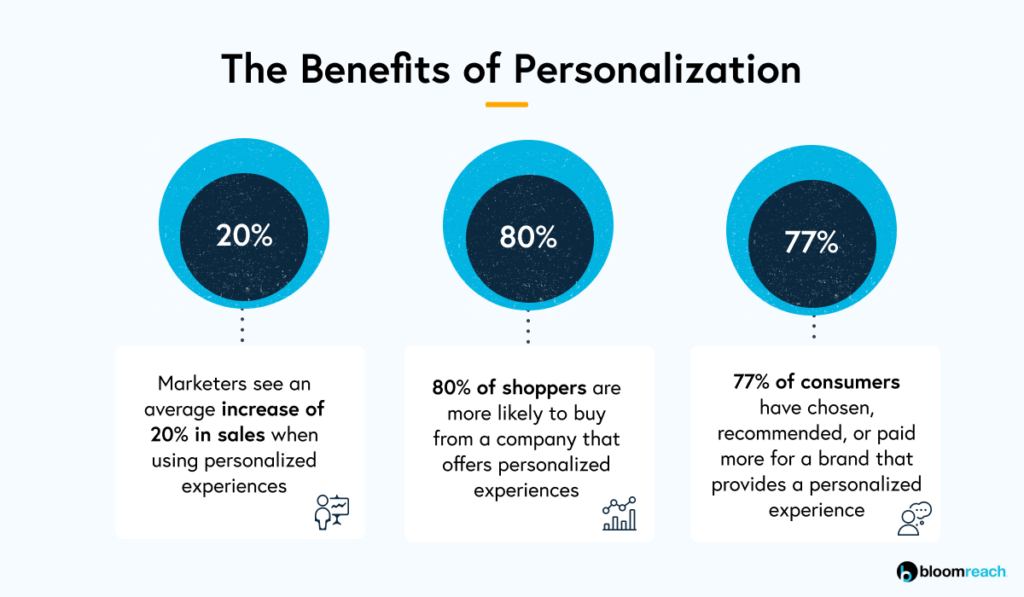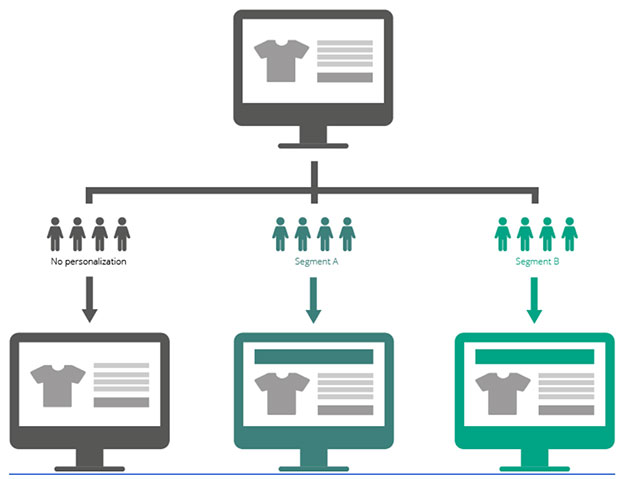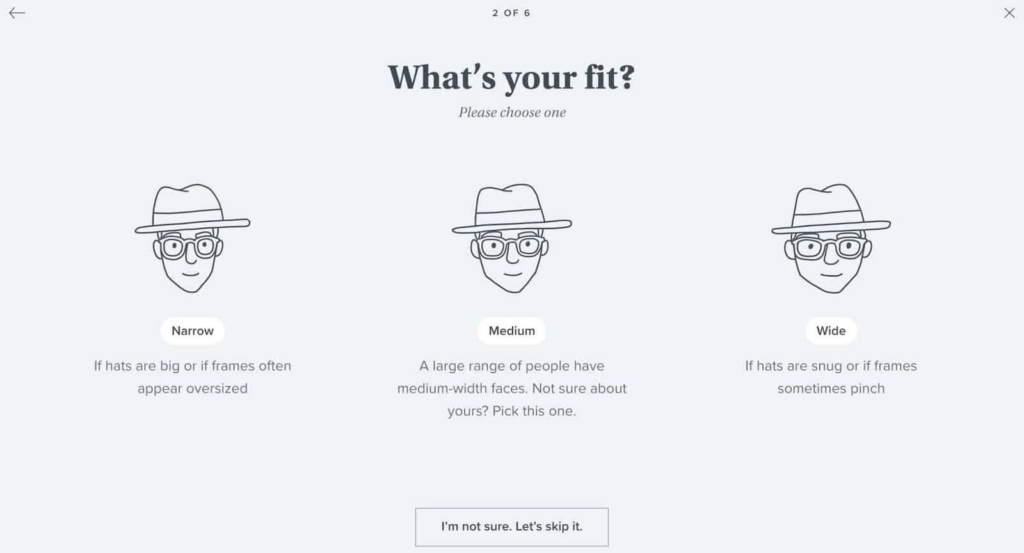The initial goal of any eCommerce is to constantly enlarge its target audience and turn the potential consumers into loyal customers. And, one of the best ways to adapt any online commerce to customer needs and expectations is to implement various personalization methods.
However, along with the diversity of personalization technologies, it becomes really challenging to define the process of eCommerce personalization and how it can benefit your business. So, it is critical to understand how that process works, why it is that important, and some great ways of implementing eCommerce personalization to your business.
In this article
Definition: What is eCommerce Personalization?
In general, eCommerce personalization is the process of improving the personal experience of the consumers on the eCommerce sites using the targeted content, product recommendations, and specific promotions created after the analysis of users’ interaction with the website, their purchase behavior, personal data, location and other information that can help to target different audience segments.
The process of personalization can greatly enhance the sales by providing the consumers with the specific offers they are certainly interested in, thus turning the accidental one-time buyers into the loyal customers of your platform. Additionally, it helps to increase the interaction with your audience and show their value for your business.
Is it effective for eCommerce? Yes, and here are the real numbers from the Accenture report to prove that:
- 91% of consumers are more likely to purchase the products from the platforms that provide the relevant offers and useful recommendations to them.
- 83% of shoppers don’t mind sharing their personal data in return for the personalized experience.
- 74% of consumers suggest running the “live profiles” if they are used not to define their journeys but enhance their shopping experience, providing the specific offers and products they’re interested in.
Benefits of Implementing the eCommerce Personalization
Now that you know what personalization in eCommerce means, it’s time to cover the benefits you can get from applying this experience to your business development strategy.

1. Get a Higher ROI
It goes without saying, that every business strategy is targeted at enlarging their revenue and getting a higher return on their business activity. With the personalizing consumers’ experience, you can note the significant increase of your sales, as people become more encouraged for the product or service’s purchase.
According to Forbes, 56% of consumers are more likely to return to the eCommerce platform after being offered the exact product they need
2. Increase the Number of Loyal Customers
Having got a personalized shopping experience can greatly increase customer retention. For example, recall in the memory your few last online purchases: were they made from unknown shopping platforms or the websites you like the most because of your recent experience? The answer lies on the surface.
Customer loyalty mostly depends on their impressions about the shopping experience on your website. By constantly increasing the level of audience satisfaction, you will certainly enlarge the number of your loyal clients. However, you have also to keep in mind that eCommerce personalization shall be a permanent process since the audience preferences and requirements are regularly changing.
3. Target Different Audiences
Audience segmentation is one of the most effective methods to target your potential consumers and make the most of your marketing campaign. By dividing your audience according to the different criteria, like occupation, interests, age, region, some personal details, and others, it becomes much clearer on how to create an effective strategy for meeting their expectations and requirements.

Besides, this method can help you to reach the new markets and identify the gaps you should improve for the eCommerce improvement.
4. Detect the Weak Points of Your Business
However, the eCommerce personalization is not only the audience and revenue increasing. It also implies the detailed analysis of your business performance and creating an effective strategy of how this can be enhanced. By providing the eCommerce sales performance case study, you will get the great eCommerce statistic for brainstorming your next targets and how you can change the present state of affairs for the better.
Furthermore, by analyzing your competitor’s performance, you are getting a wonderful source of information related to the audience preferences, which can help you to personalize their experience from making their purchase on your eCommerce platforms.
5. Prove Your Value for the Consumers
Another way you can personalize your eCommerce platform is to provide your customers with the critical information they can easily apply in their life. That can be the insights about the products’ usage, the top-rated products used for resolving the pains they used to face, some tips on improving their daily routine with the products, etc.
All these ordinary things can in fact make a giant influence on people’s behavior. By getting their trust and showing your value, you are more likely to meet consumers’ expectations and needs, thus targeting different audience segments from various industries.
Main Challenges of the eCommerce Personalizing
After discovering the main advantages you can get with personalizing your website to the customers’ needs and preferences, it’s time to cover the main challenges to achieving eCommerce personalization success. Because of the covering various customers data, it should also include the following issues:
- Data Processing. The various consumers’ data needs huge investments of time, money, and resources to discover the main preferences of the visitors and target various audience segments.
- Effective Analysis. The data analysis should be completed in short terms to get the momentum of the changes needed at a certain period of time.
- Complex Personalization Processes. Personalization is not about the one change implemented to your eCommerce platform. Instead, it should be presented by the list of specific improvements that can help you to enhance the consumer experience, which results in a better ROI.
- CMS Systems Improving. The content management systems are one of the leading ways to boost the website’s traffic and reach a large audience in really short terms. However, eCommerce personalization implies making the most comfortable and adjustable online shopping platform, which is not always possible if the CMS system offers only using the standard templated website samples for your business. And, that’s the exact case when you have to consider moving to another system that can be fully adjusted to the changes you need.
As you can see, there are plenty of factors you should also keep in mind while conducting eCommerce optimization for your online shop. Let’s now discover how to make that process correct and fully optimized to your new personalized model.
How to Apply the eCommerce Personalization Right
Having decided to conduct the eCommerce personalization for your website, it is critical to remember this process should become the permanent part of your business development strategy to reach the targets you are focusing on. But, at the same time, business personalization is not that complicated as you might think at first, and here is a detailed step-by-step guide on how to easily implement this improvement to your business.
Stage 1
Analyze your current metrics, and what do you expect from the website personalization. Start brainstorming the very first methods of what should be changed on first and why. Additionally, these methods should cover the results you expect for the revenue increasing.
Stage 2
Study the basic tools and methods that will help you in conducting the personalization for eCommerce, learn the most popular case studies for getting the overall idea about the peculiarities of this process.
Stage 3
Make records about the steps you conduct for the business personalization and audience targeting, choose the person who will analyze the progress of your project, and measure the gains.
Stage 4
Write out the list of tasks that are to be done on every step. Just like we said before, this process is not a short-term one, so make sure you have covered enough time for making the most of this strategy.
Stage 5
Start gradually implementing the changes to your eCommerce platform and find out which aspects of your business receive the benefits of it. Remember, you can’t expect to get giant changes in a day after you conducted a certain improvement, so give the personalization project some time to prove its effectiveness.
Stage 6
Record your first results from the eCommerce personalization. Track the changes given in different areas of your business, what has changed, and define the most effective methods for their further development
Stage 7
Go on moving in the personalization process by targeting new larger audience segments. Consider the additional ways to enhance the process and get the most of your eCommerce website.
Examples of the Successful eCommerce Personalization
The marketing method of eCommerce personalization is now widely used by popular brands and famous shopping platforms. Here are the case studies of the huge business corporations you might certainly know about.
Amazon
One of the most popular eCommerce platforms you remember in the first seconds is Amazon. With getting the leading positions in the sales statistics, it is now considered to be the most personalized website for online shopping for years. Basically, you are involved in the personalization process after you click the homepage, as the website covers all the possible products you might want to purchase.
The main tactics of Amazon are to track your on-site behavior and display the products based on your browsing history, purchase list, and the products which you have already added to your cart. Additionally, you can easily find the list of recommended products you might be interested in after you have bought something from a certain category. For instance, if you have purchased the office chairs for your remote work at home, the shopping platform will also suggest your buying the computer desk. Sounds really awesome, isn’t it?
Just like Amazon, Facebook also conducts content personalization by analyzing your user behavior and offers the exact news, articles, ads, and updates according to its trending in your regions. For example, a new popular marketing trend for the eCommerce platforms is Facebook targeting, which implies producing the specific content and making the most attractive offers for the audience, who is more likely to buy your product or services. By analyzing and personalizing the data ensures the perfect audience targeting for getting its highest outreach and maximizing the revenue as well.
The Iconic
The Iconic clothing online shop is also doing well with consumer personalization and audience targeting. They try to get the general information about their users for displaying them the relevant products they might consider purchasing.
For instance, they offer a $20 discount for the order by only stating their gender when signing up for the newsletter. Thus, for the next time, the shoppers will be able to get personalized offers without any necessity to open the filters for the products they would like to get.
Furthermore, that’s a great option for conducting a personalized marketing campaign, like the widely used email marketing, as you can provide your potential consumers and loyal customer with the specific deals they might be interested in. As a result, by implementing such a simple trick, the Iconic managed to improve the customers’ experience via personalization.
Warby Parker
One of the most catching and stylish methods of eCommerce personalization certainly is presented by the premium eyeglasses brand Warby Parker. They have created a simple and useful quiz for defining the user preferences and targeting each customer of their website.
By completing the quiz before getting the list of the eyeglasses for purchasing, you will get the personalized choices of products, and the eCommerce website gets the valuable information about your preferences they can easily target for your future offers.

Should You Implement eCommerce Personalization?
To conclude, eCommerce personalization is a perfect booster for enhancing your sales, increasing your audience, and getting your online shopping platform onto the next level of development. Being already implemented with famous brands and huge companies, personalization can generate much more purchases, interact with the users during their shopping, and encourage them to consider some other products they might also buy.
Needless to add, eCommerce personalization is the future of improving the consumer experience during online shopping, so it’s definitely worth getting for your business right now!



